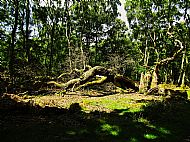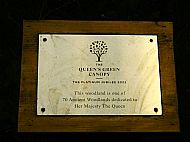Up in Brocton Coppice
Brocton Coppice in Staffordshire here in middle-England, the remnants of an ancient woodland going back some 1000 years. Once part of a Royal hunting forest demesne of…… containing many, many oak trees, but sadly only a few remain today as the ravages of time and man have eaten on to their numbers.
Charcoal burners used the oaks to create a fuel source for the local iron foundries near Rugeley, and the oaks chosen for their straightness, set to become timbers to build ships for the British navy to fight battles at sea with the Spanish and the French, oaks cut down and used for the building of local manors and estates. Some of these oaks may have been used for the construction of the army camps during the first world war, army camps which spread out over the Chase and where faint signs of their occupation can still be seen.
But today, thankfully Brocton Coppice is now safe from any further destruction by mankind as the area is protected and classed as a Special Site of Scientific Interest, so these few remaining oaks are being allowed to live out the rest of their lives untouched. Fallen boughs are left to decay naturally and become habitats for insects, fungi, and wildlife.
These remaining oaks are huge, gnarled, and very impressive and are of a great age some are believed to be eight hundred years old. One wonders what stories they could tell and what they have seen. Did Freda, the mascot of the New Zealand Rifle Brigade, stationed at nearby Brocton Camp during World War 1, run beneath the trees? She died in December 1918 and her grave is near the Coppice, the soldiers walk with their girlfriends, did they walk up there in Brocton Coppice? Did J R. Tolken, an officer at one of the army camps, cut through the Coppice on his way to see his wife at Great Haywood.
And of course, if you go back a century or so we have the charcoal burners, who cut down the oaks, let them season and slowly burn them in their fire stacks to create charcoal, the valuable fuel source for the processing of iron before coal began to be used. The smoke from those fire stacks mingling through the canopy of the oak leaves creating a hazy fog over the Coppice. It took about three days for the charcoal to be ready with the men attending the stacks constantly to maintain the right temperature, so they would live, eat, and sleep by the fires until the end of the process. There is evidence of some depressions which could have been where the charcoal burners once worked.
We could go back even further in time and guess at other activities that went on in the coppice but where do we stop? So I think we will let these oaks keep some memories and secrets to themselves, all I know is that whenever I visit Brocton Coppice and walk among the remaining giant oaks and beneath the green canopy of leaves, I am in awe of the silence and peacefulness which seems to extrude from there, and if I’m with company, I have noticed we tend to talk quietly, almost in whispers as if we are intruding into another time. Maybe Tolkin did find some kind of inspiration for his ‘Lord of the Rings’ …. up there in Brocton Coppice.
UP THERE IN BROCTON COPPICE...
Ancient oaks stand proud and tall,
Up in Brocton Coppice.
Spirits of people long time past,
Are there in Brocton Coppice.
Hunters on their steeds so fast,
Raced through the forest chasing deer
With hounds at heel baying loud.
Memories of a bygone year.
Charcoal burners once worked there
Tending their smoldering stacks of oak,
Living off the meagre land
Surrounded by the swirling smoke.
Soldiers with their sweetheart’s fair
Once lay beneath those trees.
A stolen kiss, a last goodbye,
Now live as whispers on the breeze.
Yes, spirits of the past, they live,
Up in Brocton Coppice.
And those gnarled old oaks, they know them well
Up there, in Brocton Coppice.
© Penny Vickers













